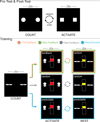Cognitive Neurostimulation: Learning to Volitionally Sustain Ventral Tegmental Area Activation
- PMID: 26948894
- PMCID: PMC5074682
- DOI: 10.1016/j.neuron.2016.02.002
Cognitive Neurostimulation: Learning to Volitionally Sustain Ventral Tegmental Area Activation
Abstract
Activation of the ventral tegmental area (VTA) and mesolimbic networks is essential to motivation, performance, and learning. Humans routinely attempt to motivate themselves, with unclear efficacy or impact on VTA networks. Using fMRI, we found untrained participants' motivational strategies failed to consistently activate VTA. After real-time VTA neurofeedback training, however, participants volitionally induced VTA activation without external aids, relative to baseline, Pre-test, and control groups. VTA self-activation was accompanied by increased mesolimbic network connectivity. Among two comparison groups (no neurofeedback, false neurofeedback) and an alternate neurofeedback group (nucleus accumbens), none sustained activation in target regions of interest nor increased VTA functional connectivity. The results comprise two novel demonstrations: learning and generalization after VTA neurofeedback training and the ability to sustain VTA activation without external reward or reward cues. These findings suggest theoretical alignment of ideas about motivation and midbrain physiology and the potential for generalizable interventions to improve performance and learning.
Copyright © 2016 Elsevier Inc. All rights reserved.
Figures






Similar articles
-
Dorsolateral prefrontal cortex drives mesolimbic dopaminergic regions to initiate motivated behavior.J Neurosci. 2011 Jul 13;31(28):10340-6. doi: 10.1523/JNEUROSCI.0895-11.2011. J Neurosci. 2011. PMID: 21753011 Free PMC article.
-
Novelty increases the mesolimbic functional connectivity of the substantia nigra/ventral tegmental area (SN/VTA) during reward anticipation: Evidence from high-resolution fMRI.Neuroimage. 2011 Sep 15;58(2):647-55. doi: 10.1016/j.neuroimage.2011.06.038. Epub 2011 Jun 24. Neuroimage. 2011. PMID: 21723396
-
Age-Related Trajectories of Functional Coupling between the VTA and Nucleus Accumbens Depend on Motivational State.J Neurosci. 2018 Aug 22;38(34):7420-7427. doi: 10.1523/JNEUROSCI.3508-17.2018. Epub 2018 Jul 20. J Neurosci. 2018. PMID: 30030394 Free PMC article.
-
Reward and aversion in a heterogeneous midbrain dopamine system.Neuropharmacology. 2014 Jan;76 Pt B(0 0):351-9. doi: 10.1016/j.neuropharm.2013.03.019. Epub 2013 Apr 8. Neuropharmacology. 2014. PMID: 23578393 Free PMC article. Review.
-
Neuroimaging and neuromodulation approaches to study eating behavior and prevent and treat eating disorders and obesity.Neuroimage Clin. 2015 Mar 24;8:1-31. doi: 10.1016/j.nicl.2015.03.016. eCollection 2015. Neuroimage Clin. 2015. PMID: 26110109 Free PMC article. Review.
Cited by
-
Free recall test experience potentiates strategy-driven effects of value on memory.J Exp Psychol Learn Mem Cogn. 2017 Oct;43(10):1581-1601. doi: 10.1037/xlm0000395. Epub 2017 Apr 10. J Exp Psychol Learn Mem Cogn. 2017. PMID: 28394160 Free PMC article.
-
Computationally Informed Interventions for Targeting Compulsive Behaviors.Biol Psychiatry. 2023 Apr 15;93(8):729-738. doi: 10.1016/j.biopsych.2022.08.028. Epub 2022 Sep 7. Biol Psychiatry. 2023. PMID: 36464521 Free PMC article. Review.
-
Earliest amyloid and tau deposition modulate the influence of limbic networks during closed-loop hippocampal downregulation.Brain. 2020 Mar 1;143(3):976-992. doi: 10.1093/brain/awaa011. Brain. 2020. PMID: 32091109 Free PMC article.
-
Expected Reward Value and Reward Uncertainty Have Temporally Dissociable Effects on Memory Formation.J Cogn Neurosci. 2019 Oct;31(10):1443-1454. doi: 10.1162/jocn_a_01411. Epub 2019 Apr 16. J Cogn Neurosci. 2019. PMID: 30990388 Free PMC article.
-
Analysis of individual differences in neurofeedback training illuminates successful self-regulation of the dopaminergic midbrain.Commun Biol. 2022 Aug 19;5(1):845. doi: 10.1038/s42003-022-03756-4. Commun Biol. 2022. PMID: 35986202 Free PMC article.
References
-
- Adcock RA, Thangavel A, Whitfield-Gabrieli S, Knutson B, Gabrieli JD. Reward-motivated learning: mesolimbic activation precedes memory formation. Neuron. 2006;50:507–517. - PubMed
Publication types
MeSH terms
Substances
Grants and funding
LinkOut - more resources
Full Text Sources
Other Literature Sources

